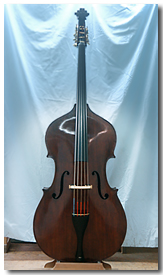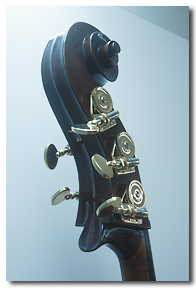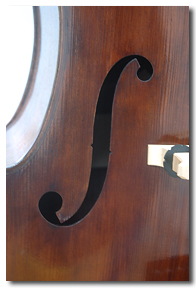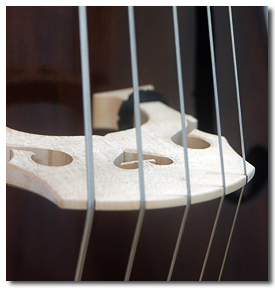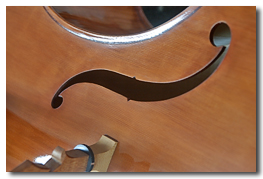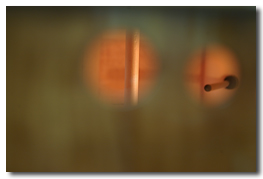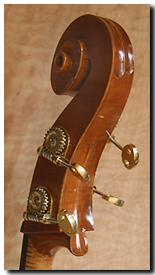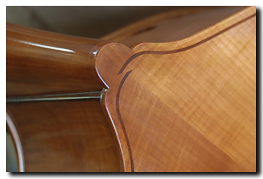| |



click
image for larger view!
|
|
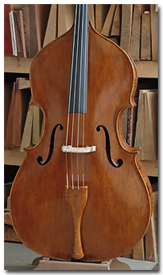 click
image
click
image |
|
|
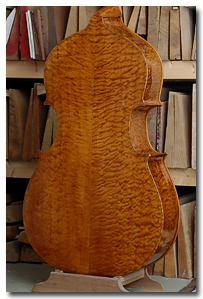 click
image
click
image |
Arnold
Schnitzer,
New York. 2013, #33. 7/8 modified Testore (orchestral) model.
Flat back and ribs of 40 year old quilted Big Leaf maple; Top
of Engelmann spruce; German maple scroll (pre-carved).
41 1/4" (104.8 cm.) string length. $SOLD.
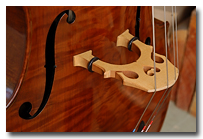
Arnold Schnitzer,
New York. 2012, #29.
7/8 modified Montagnana model; *Round back and ribs of Genuine
mahogany; Top of curly Pacific Redwood; Maple neck; Massaranduba
C-extension and nut.
41 5/8" (105.7 cm.) string length.
$SOLD.
Arnold E. Schnitzer,
New York. 2013, # 34. 3/4 roundback Testore derived. 1 piece
back of walnut, walnut sides, Sitka spruce top, maple neck.
41 1/8" (104.5 cm.) string length.
$SOLD.
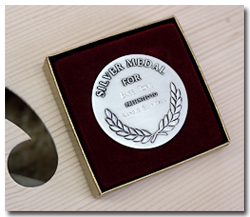
click
for larger image
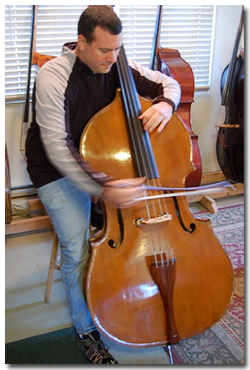
"Hands
down the best modern bass I have ever played. It plays like a
dream, sounds super-clean, has really quick response, and just
looks amazing."
Staff Sergeant
Philip Helm of the USMA West Point Band
This
bass, a modified Montagnana-style 7/8, won a Silver Medal for
Tone at the 2012 Violin Society of America maker's competition.
The Silver Medal is the highest award a maker can receive for
tone.
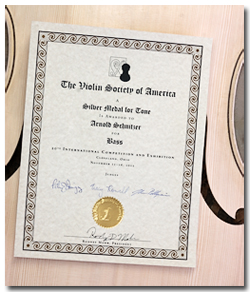
click
for larger image
|
|
This
bass was made in 2003 for Louis Pappas, who plays for the United
States Army at West Point as well as several local orchestas and
combos.
The
back and ribs are made of highly figured quilted bigleaf maple,
which was salvaged from a cabinet shop in Washington State. The
seller informed me that the wood was at least 25 years old at the
time I purchased it (about 5 years ago). This wood is extremely
difficult to work with. When I showed the bass to my colleague,
Barrie Kolstein, at the recent ISB conference in Richmond, he shook
his head and told me, "You are a masochist!"
The
top is made of three pieces of Sitka spruce I acquired from my friend
and mentor, Lou Di Leone. The wood was cut in the 1930's for his
father, Frank, who did not use it because one of the two original
planks was too thin. My solution was to cut the thinner plank in
half, and attach these pieces to the outsides of the thicker plank.
This allowed me to carve a normal arch into the top.
The
neck is bigleaf maple of a less-figured variety than the back and
ribs. I felt that too much figure in the neck wood might make the
bass look like a person wearing a plaid shirt and paisley tie (my
favorite mode of dress!).
With
the old wood, this bass delivers thunderous bottom. The old Sitka
top gives it a dark but woody sound that does not thin out in the
upper register. But please don't ask; I have no desire to work with
this maple again in the foreseeable future!
While
I adhere fairly religiously to the Italian masters' building techniques,
there are a few unique touches in my basses: Graphite reinforced
neck, for enhanced stabilty; specially carved and braced back, which
increases volume and depth; scroll carved from the get-go with a
C-extension in mind. I build slowly, which allows the properly-aged
wood to stabilize, and prevents tension from being built in to the
instrument.
All
my basses are oil-varnished the old-fashioned way, with a brush,
adequate dry-time between coats, and a laborious rub-down to a rich
semi-gloss patina. I do not use spirit varnish, shellac or lacquer
on my carved instruments, as they can have a negative impact on
tone. There is no substitute for time in the building and finishing
process.
I also
build a slightly scaled-down version of the bass pictured above.
This instrument is 3/4 size with narrower shoulders and a shorter
lower bout. These changes were made to accommodate a bassist more
involved in solo playing, and who sought an instrument with a more
direct sound when played in orchestra section. Both styles can be
built with either flat or round back.
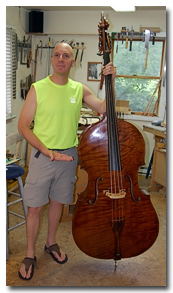 I
am very happy with my new bass made by Arnold Schnitzer. The tone
is beautiful, and it is clear, loud and even throughout all registers.
The craftsmanship is impeccable, and it is very easy to play. I
am very happy with my new bass made by Arnold Schnitzer. The tone
is beautiful, and it is clear, loud and even throughout all registers.
The craftsmanship is impeccable, and it is very easy to play.
Thanks Arnold!
Leigh Mesh
Associate Principal Bass
Metropolitan Opera Orchestra
|
|
|
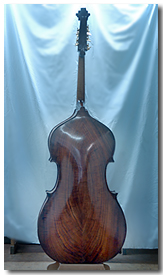 (Click
for larger view.)
(Click
for larger view.) |
|
|
|
|
|
|
|
|
Bass #19
by Arnold E. Schnitzer, 2008. Back and ribs of Oregon Black Walnut; Sitka
spruce top; Sugar Maple neck; 5 string with low B; 41 3/4" string
length (105.7 cm). I redesigned my "Modified Testore" orchestral
model, widening the upper block and shoulders slightly, and making the
corners protrude less. The top has a slightly higher arch and the neck
overstand is increased, allowing for comfortable bowing on all five strings.
This bass has been sold.
Pictured
above is the Ergonomic Contrabass IV. This bass received
an Honorable Mention for convention favorite at the 2009 ISB convention.
Amongst the players who were complimentary toward it were Mark Dresser,
Jeff Bradetich, Linda McKnight, Mark Helias, Carlos Henriquez and Tim
Cobb.
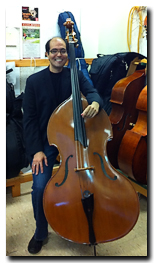 "For
a musician, one of the most important things is to find an instrument
that plays and feels like it’s a part of them — becomes their
voice. Arnold Schnitzer’s Ergonomic Bass #4 is what I have been searching
for throughout my musical career. It’s fantastic customizable tone
combined with ease of playing and super fast response all while being
one of the most well built instruments I have ever seen makes it ideal.
His eye for detail and his strive for absolute perfection is astounding
to say the least. I have finally found my voice, thank you Arnold!" "For
a musician, one of the most important things is to find an instrument
that plays and feels like it’s a part of them — becomes their
voice. Arnold Schnitzer’s Ergonomic Bass #4 is what I have been searching
for throughout my musical career. It’s fantastic customizable tone
combined with ease of playing and super fast response all while being
one of the most well built instruments I have ever seen makes it ideal.
His eye for detail and his strive for absolute perfection is astounding
to say the least. I have finally found my voice, thank you Arnold!"
Kurt
Muroki
Chamber Music Society of Lincoln Center
Faculty, Julliard Pre-College
Bass Professor, SUNY at Stony Brook
Ergonomic
Contrabass III is pictured directly below and is no longer available.
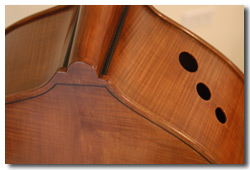
Ergonomic
Contrabass II— Won two awards at the International Society
of Bassists 2005 Makers' Competition:
- Certificiate
of Tone
- Honorable
Mention, Convention Favorite
Conceived
as a combination orchestral/solo instrument, it is asymmetrical as a matter
of form following function. The upper bout is wide enough to allow for
a deep, puchy tone, yet the reduced treble side shoulder provides outstanding
access to the upper register. The lower bout of the treble side was enlarged
by the same amount as the reduction in the upper bout in order to maintain
tonal balance between the treble and bass halves. The back slopes gently
up to a thin neck block, allowing the player to nestle closely to the
bass, keeping the bow arm in a naturally relaxed position. Along with
ergonomic developments, the bass features unique back bracing, top arching
and bass bar, all designed to reduce seasonal fluctuations and improve
tone.
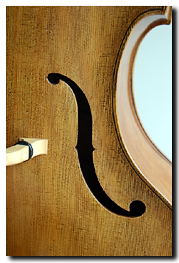
The f-holes
are an aggregate of violin-family and plectrum guitar designs. The shape
of the body was conceived to be corner-less; the upper corners are a concession
to practicality. [The string length is 41" (104 cm) and the bass
could be considered a long 3/4 size.] Made of curly maple, with an Engelmann
spruce top.
Ergo II is
currently owned by Nathan Vedal
and is no longer available.
Models
available for commission include Montagnana-style (7/8 and 3/4), Testore
copy (large 3/4) and the unique "Ergonomic Contrabass".
Handmade
basses by Arnold E. Schnitzer are currently in use in the following orchestras:
- American
Symphony
- Chamber
Music Society of Lincoln Center
- NY City
Ballet
- NY Metropolitan
Opera
- NY Pops
- Nashville
Symphony
- Charleston
Symphony
- Albany,
NY Symphony
- Buffalo
Symphony
- Stamford,
CT Symphony
- US Army,
West Point
- Florida
West Coast Symphony
In addition,
you can hear bass #1 on The Little Bill Show, a cable TV cartoon
show.
© 2017 Arnold Schnitzer. All rights reserved
|
|

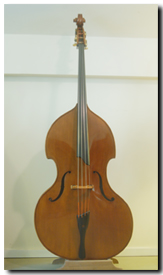
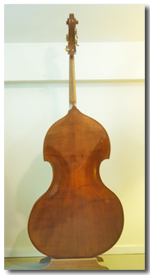
 "For
a musician, one of the most important things is to find an instrument
that plays and feels like it’s a part of them — becomes their
voice. Arnold Schnitzer’s Ergonomic Bass #4 is what I have been searching
for throughout my musical career. It’s fantastic customizable tone
combined with ease of playing and super fast response all while being
one of the most well built instruments I have ever seen makes it ideal.
His eye for detail and his strive for absolute perfection is astounding
to say the least. I have finally found my voice, thank you Arnold!"
"For
a musician, one of the most important things is to find an instrument
that plays and feels like it’s a part of them — becomes their
voice. Arnold Schnitzer’s Ergonomic Bass #4 is what I have been searching
for throughout my musical career. It’s fantastic customizable tone
combined with ease of playing and super fast response all while being
one of the most well built instruments I have ever seen makes it ideal.
His eye for detail and his strive for absolute perfection is astounding
to say the least. I have finally found my voice, thank you Arnold!"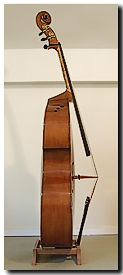
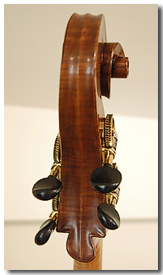



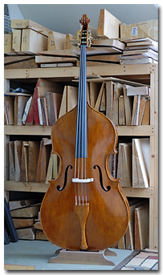

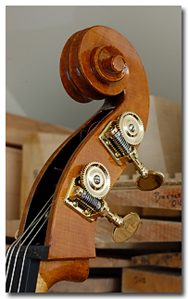

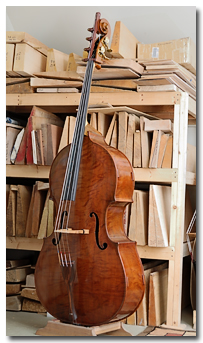
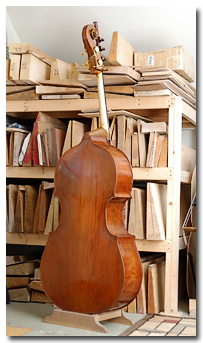
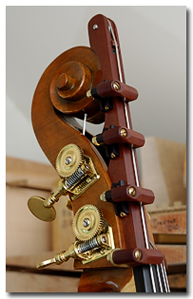
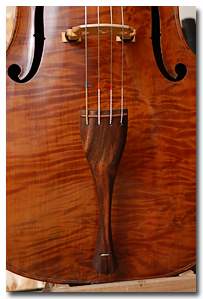

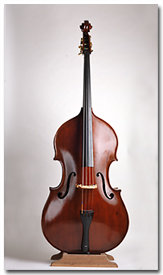
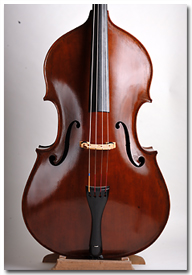
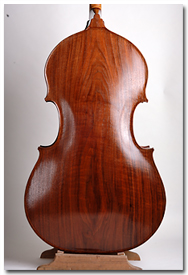
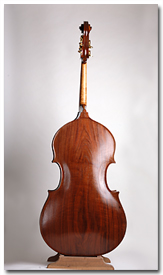











 I
am very happy with my new bass made by Arnold Schnitzer. The tone
is beautiful, and it is clear, loud and even throughout all registers.
The craftsmanship is impeccable, and it is very easy to play.
I
am very happy with my new bass made by Arnold Schnitzer. The tone
is beautiful, and it is clear, loud and even throughout all registers.
The craftsmanship is impeccable, and it is very easy to play. 